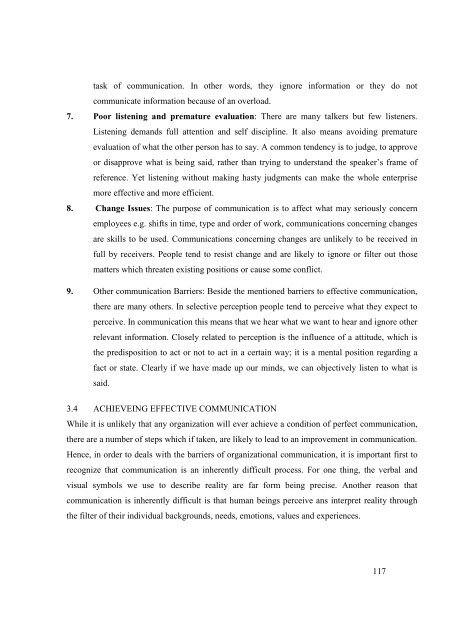HCM 433 MANGEMENT AND ORGANIZATIONAL BEHAVIOUR.pdf
HCM 433 MANGEMENT AND ORGANIZATIONAL BEHAVIOUR.pdf
HCM 433 MANGEMENT AND ORGANIZATIONAL BEHAVIOUR.pdf
You also want an ePaper? Increase the reach of your titles
YUMPU automatically turns print PDFs into web optimized ePapers that Google loves.
task of communication. In other words, they ignore information or they do not<br />
communicate information because of an overload.<br />
7. Poor listening and premature evaluation: There are many talkers but few listeners.<br />
Listening demands full attention and self discipline. It also means avoiding premature<br />
evaluation of what the other person has to say. A common tendency is to judge, to approve<br />
or disapprove what is being said, rather than trying to understand the speaker’s frame of<br />
reference. Yet listening without making hasty judgments can make the whole enterprise<br />
more effective and more efficient.<br />
8. Change Issues: The purpose of communication is to affect what may seriously concern<br />
employees e.g. shifts in time, type and order of work, communications concerning changes<br />
are skills to be used. Communications concerning changes are unlikely to be received in<br />
full by receivers. People tend to resist change and are likely to ignore or filter out those<br />
matters which threaten existing positions or cause some conflict.<br />
9. Other communication Barriers: Beside the mentioned barriers to effective communication,<br />
there are many others. In selective perception people tend to perceive what they expect to<br />
perceive. In communication this means that we hear what we want to hear and ignore other<br />
relevant information. Closely related to perception is the influence of a attitude, which is<br />
the predisposition to act or not to act in a certain way; it is a mental position regarding a<br />
fact or state. Clearly if we have made up our minds, we can objectively listen to what is<br />
said.<br />
3.4 ACHIEVEING EFFECTIVE COMMUNICATION<br />
While it is unlikely that any organization will ever achieve a condition of perfect communication,<br />
there are a number of steps which if taken, are likely to lead to an improvement in communication.<br />
Hence, in order to deals with the barriers of organizational communication, it is important first to<br />
recognize that communication is an inherently difficult process. For one thing, the verbal and<br />
visual symbols we use to describe reality are far form being precise. Another reason that<br />
communication is inherently difficult is that human beings perceive ans interpret reality through<br />
the filter of their individual backgrounds, needs, emotions, values and experiences.<br />
117
















